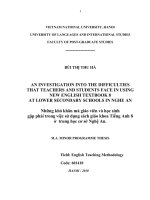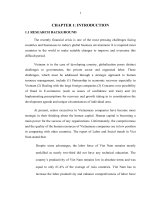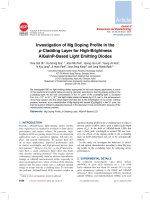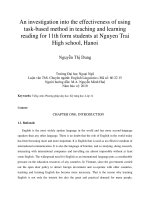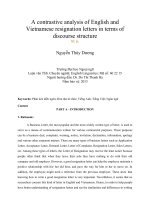Investigation of the regulatory network involving agamous like 24 in floral transition of arabidopsis
Bạn đang xem bản rút gọn của tài liệu. Xem và tải ngay bản đầy đủ của tài liệu tại đây (2.39 MB, 106 trang )
Investigation of the regulatory network
involving AGAMOUS-LIKE 24 in floral
transition of Arabidopsis
Wen Tianfan (B. Sc)
A thesis submitted to Department of Biological Sciences
The National University of Singapore
In partial fulfillment for the Degree of Master of Sciences
12/2005
Table of Contents
Acknowledgments
IV
List of Abbreviations
V
List of Tables
VIIIII
List of Figures
IX
Summary
X
1 Literature review
1
1.1 Introduction
1
1.2 Flowering Time
3
1.3 Genetic Pathways in the Control of Flowering Time
5
1.3.1 Autonomous Pathway
5
1.3.2 Vernalization Pathway
7
1.3.3 Photoperiod Pathway
8
1.3.4 Gibberellin Pathway
9
1.4 Integration of Flowering Time Control Pathway
10
1.5 AGL24
11
1.6 The MADS-box Protein Family
14
1.7 Methods Used for the Investigation of AGL24-related Regulatory Network
18
1.7.1 Promoter Studies
18
1.7.2 Chromatin Immunoprecipitation (ChIP)
18
I
1.7.3 In Situ Hybridization
19
2 Material and Methods
21
2.1 Plant Material
21
2.2 Vector Construction
21
2.2.1 Genomic DNA Extraction
21
2.2.2 Promoter reporter constructs
22
2.2.3 Construction of pGreen 35S-AGL24-12HA
27
2.3 Plant transformation
28
2.4 Detection of GUS Reporter Gene
29
2.4.1 Fixation
29
2.4.2 Staining
29
2.4.3 Dehydration
30
2.4.4 Observation Under Microscope
30
2.5 ChIP
30
2.5.1 Nuclear fixation
30
2.5.2 Homogenization and sonication
31
2.5.3 Immunoprecipitation
33
2.5.4 DNA recovery
34
2.5.5 Linker Modification and PCR Amplification
34
2.5.6 Western Blot Analysis
36
2.5.7 Analysis on Co-precipitated DNA
36
2.6 Non-radioactive RNA-RNA In Situ Hybridization
II
38
2.6.1. Synthesis of DIG Labeling mRNA Probe
38
2.6.2 Fixation of In Situ Materials
40
2.6.3 Dehydration, Embedding and Section
40
2.6.4. In Situ Section and Pretreatment
42
2.6.5 Hybridization
42
2.6.6 Wash and Detection
43
3 Results and Discussion
45
3.1 Investigation of the Regulatory Region of AGL24
45
3.1.1 GUS Constructs
45
3.1.2 Transgenic Plants
49
3.1.3 GUS staining results
49
3.2 Identification of AGL24 Target Genes by ChIP
64
3.2.1 Production of Functional Trasngeneic Tagging Lines
64
3.2.2 Sonication
68
3.2.3 Western Blot
68
3.2.4 Linker Ligation
70
3.2.5 Sequence analysis
71
3.3 Nonradioactive RNA-RNA In situ Hybridization
74
3.3.1 Putative AGL24 Target Genes
74
3.3.2 In Situ Hybridization Results
75
Conclusion
80
Reference
81
III
Acknowledgments
I would like to acknowledge my gratitude and appreciation to my supervisor,
Assistant Professor Yu Hao for given me the opportunity to work on this project and for his
constant guidance and unfailing support, encouragement and patience throughout the course
of my studies in his laboratory.
I gratefully would like to thank my seniors, Lu Chen, Yi Feng, and Lai Lai, whose
help and guidance have been generous and cherished. Special thanks to my friends Liu
Chang and Hong Ling for their support.
Last but not least, my most sincere thanks to my parents and sister for their
unconditional love, support, and understanding.
Wen Tianfan
30 Dec 2005
IV
List of Abbreviations
Chemicals and reagents
dGTP
deoxyguanosine triphosphate
dNTP
deoxynucleoside triphosphate
EDTA
ethylene-diamine-tetra-acetate
Gly
glycine
HCl
hydrochloric acid
K3Fe(CN)6
potassium ferricyanide
K4Fe(CN)6
potassium ferrocyanide
KPO4
potassium phosphate
LB
Luria bertani
LiCl
lithium chloride
MgCl2
magnesium chloride
NaCl
Sodium chloride
Na2HPO4
disodium Phosphate
NaH2PO4
sodium Phosphate (dibasic)
NaPO4
sodium phosphate
PBS
phosphate buffered saline
PMSF
phenylmethylsulfonylfluoride
SDS
sodium dodecylsulphate
Tris
Tris (hydroxymethyl)-aminomethane
V
Units and measurements
bp
base pairs
g
gram(s)
h
hour(s)
kb
kilo base-pairs
kDa
kilo Dalton(s)
M
Molar
min
minute(s)
ml
mililitre(s)
mM
Milimolar
ng
nanogram(s)
OD600nm
absorbance at wavelength 600 nm
rpm
revolution per minute
sec
second(s)
U
unit(s)
v/v
volume per volume
w/v
weight per volume
°C
Degree Celsius
µg
microgram(s)
µl
microlitre(s)
µM
Micromolar
VI
Others
BLAST
Basic Local Alignment Search Tool
DNA
deoxyribonucleic acid
et al.
et alter (and others)
GA
gibberellin
i.e.
that is
LD
long day
mRNA
messenger ribonucleic acid
PCR
polymerase chain reaction
RT-PCR
Reverse Transcription Polymerase Chain Reaction
SAM
short apical meristem
SDS-PAGE
SDS Polyacrylamide Gel Electrophoresis
SD
short day
TAE buffer
tris acetate electrophoresis buffer
VII
List of Tables
Table 1. Differences between supfamilies of MADS-box genes
17
Table 2. List of primers used to amplify various genomic fragments used for promoter
analysis
24
Table 3. Isolation of transgenic plants containing different promoter constructs
51
Table 4. Candidate genes isolated by ChIP can be used for further functional studies
72
VIII
List of Figures
Fig. 1 The four distinct genetic pathways regulate flowering time in Arabidopsis
Fig. 2 Phenotype of AGL24 mutant plants
6
12
Fig. 3 Diagram showing the fragments of AGL24 genomic sequence used for
promoter analysis
23
Fig. 4 pGreen vectors used for cloning
25
Fig. 5 Flowchart of ChIP work
32
Fig. 6 Genomic sequence of AGL24
46
Fig. 7 Transgenic plant bearing different AGL24 promoter:: GUS constructs
50
Fig. 8 GUS expression in AGL24-P4 plants on day 8 to 16 after germination
53
Fig. 9 GUS expression in AGL24-P4 Plants on day 18 to 25 after germination
54
Fig. 10 GUS expression in AGL24-P5 plants on day 8 to 16 after germination
56
Fig.11 GUS expression in AGL24-P5 plants on day 18 to 25 after germination
57
Fig. 12 GUS expression in AGL24-P2 plants on day 8 to 20 after germination
58
Fig. 13 GUS expression in AGL24-P3 plants on day 8 to 20 after germination
60
Fig. 14 Schematic diagram summarizing the required regulatory elements for the
normal AGL24 expression
61
Fig. 15 Over-expression of AGL24-12HA fusion protein was able to induce early
flowering as overexpression of AGL24
65
Fig. 16 Flower phenotypes in 35S::AGL24-12HA transgenic plants
67
Fig. 17 AGL24-12HA fusion protein was purified
69
Fig. 18 TFL1 expression pattern
76
Fig. 19 SVP expression pattern
78
IX
Summary
Flowering is one of the most essential processes in the life cycle of a flowering plant.
It requires a transition from vegetative to reproductive growth, which is regulated by four
genetic pathways, including gibberellin (GA), photoperiod, venalization and autonomous
promotion pathways. Photoperiod and venalization pathways respond to environmental
signals, while GA and autonomous pathways sense endogenous signals. They activate the
expression of a group of flowering time integrators to promote the transformation of the
vegetative shoot apical meristem (SAM) into the inflorescence SAM, which has the capacity
to generate floral meristems on its flankings.
We have known that a MADS-domain containing transcription factor, AGAMOUSLIKE 24 (AGL24), plays an important role in integrating flowering time signals in
Arabidopsis. AGL24 is a dosage-dependent promoter of flowering in Arabidopsis, because
loss-of-function agl24 mutants show late flowering and overexpression of AGL24 transgenic
plants show early flowering. Loss of AGL24 function can suppress the premature flowering
phenotype of overexpression of SOC1 and overexpression of AGL24 can partially rescue the
late flowering phenotype of soc1. Thus, AGL24 acts partly downstream of SOC1. In addition,
AGL24 affects the transcriptional induction of a floral meristem identity gene, LEAFY (LFY)
because LFY expression is delayed and reduced in agl24 mutants during floral transition,
whilst over-expression of LFY is able to compensate the late flowering phenotype of agl24.
Therefore, AGL24 functions upstream of LFY. Although the above results suggest that
AGL24 is an essential flowering time integrator, it is hitherto unknown what are the direct
regulators upstream or downstream of AGL24.
X
In this study, chromatin immunoprecipitation (ChIP) was applied to identify the
downstream target genes of AGL24. Firstly, 35S::AGL24-12HA tagging transgenic lines were
generated and showed the similar phenotypes as 35S::AGL24, indicating that 35S::AGL2412HA fusion protein is biologically functional. Secondly, by using these tagging lines and the
specific HA antibody, it was purified that the in vivo complex containing the AGL24-12HA
fusion protein and associated DNAs. Lastly, several putative target genes were identified by
cloning and sequencing isolated DNA fragments in ChIP experiments.
To study the molecular basis of the regulation of AGL24, the AGL24 promoter was
isolated and this regulatory region was investigated by promoter deletion analysis.
To facilitate our further studies of AGL24 target genes, an in situ hybridization system
was established to examine the spatial and temporal expression of a specific gene. By using
this system, the altered expression of two putative target genes of AGL24 has successfully
detected. Through these studies, we gained sights into the mechanism of AGL24 function in
the control of floral transition in Arabidopsis.
XI
1 Literature review
1.1 Introduction
Flowering is one of the most essential phases in the life cycle of a flowering plant.
It requires a transition from vegetative to reproductive growth, which is controlled by a
group of flowering time genes in response to environmental and endogenous
developmental signals. The complexity of this transition is reflected by an intricate
network of several flowering promotion pathways (Mouradov et al., 2002).
At least four genetic pathways have been suggested to control flowering time in
plants. Vernalization and photoperiod pathways capture environmental signals, while
autonomous and GA pathways respond endogenous developmental signals. The genes
immediately downstream of these four pathways are flowering integrators that integrate
environmental and endogenous cues regulating floral transition and the subsequent flower
development. LFY, FLOWERING LOCUS T (FT) and SOC1 are three critical flowering
time integrators. The expression of FT and SOC1 are regulated positively by the
photoperiod pathway, but negatively by FLOWEIRNG LOCUS C (FLC), which is an
important regulator integrating the signals from the vernalization and autonomous
pathways. SOC1 can be up-regulated by the GA pathway as well (Komeda, 2004). LFY is
the most critical regulator located very downstream of flowering time pathways, which
controls the switch form flowering time control to flower development (Blazquez et al.,
1997).
Arabidopsis is an excellent model system to study the control of flowering time,
because it responds to typical environmental conditions that affect flowering in a wide
1
range of plant species (Mouradov et al., 2002). Arabidopsis also offers several additional
advantages for the research in the regulation of flowering, including the rapid life cycle,
prolific seed production, efficient transformation systems and established genetic
molecular tools for studying Arabidopsis genes.
Genetic and molecular studies in
Arabidopsis have shown that a lot of MADS-box genes are required for plant
reproduction development (Pařenicová et al., 2003). AGL24 is one of the MADS-domain
containing transcription factors, which plays an important role in the regulation of
flowering time (Yu et al., 2002; Michaels et al, 2003). As a dosage-dependent mediator
of the flowering signals, the levels of AGL24 expression determine the flowering time in
Arabidopsis. Although it has been suggested that AGL24 acts downstream of SOC1 and
upstream of LFY (Yu et al, 2002), there is no evidence for the direct relationships
between these genes. Some other intermediators may function in the gaps. To investigate
the regulatory components downstream and upstream of AGL24, we planned to use ChIP
to identify AGL24 target genes and to use promoter deletion analysis to dissect ciselements responsible for the regulation of AGL24.
2
1.2 Flowering Time
The general body plan of plants is established during embryogenesis, when the
undifferentiated meristematic regions of root and shoot are set aside. Much of plant
development occurs postembryonically, through the reiterative production of organ
primordia at the SAM. In flowering plants, the SAM initially gives rise to vegetative
organs such as leaves, but at a specific point the SAM makes the transition to
reproductive development and then produces flowers (Levy & Dean, 1998).The induction
of flowering in plants is the most important part from the standpoints of reproductive
strategy and allocation of limited resources. Monocarpic plants, such as Arabidopsis,
perform the flowering only once in their lifecycle, and the reproductive success depends
entirely on this one opportunity (Komeda, 2004).
During floral transition, the change in the developmental fate of primordia
initiated at the SAM is controlled by environmental and endogenous signals (Bernier,
1988; McDaniel et al., 1992). Unlike many developmental transitions in animals, the
SAM of plants is not irreversibly "committed" to reproductive development once
flowering commences. In some species and genotypes under certain environmental
conditions, flowers can be transformed back into leafy shoots in a phenomenon known as
the inflorescence reversion (Battey & Lyndon, 1990; Pouteau et al., 1997). This
observation implies that the genes and processes involved in the transition to flowering
are required for both the initiation and maintenance of flower development.
The endogenous signals for floral transition in many species can accumulate in
vegetative tissues. These internal cues include plant size or number of vegetative nodes.
3
The vegetative SAM is thought to first pass through a "juvenile" phase in which it is
incompetent to respond to internal or external signals that would be able to trigger
flowering in an "adult" meristem (Levy & Dean, 1998). The acquisition of reproductive
competence is then marked by changes in the morphology or physiology of vegetative
structures. For example, the alteration of leaf morphology may indicate the competence
for floral transition in a process known as vegetative phase change (Poethig, 1990;
Lawson & Poethig, 1995). It is likely that some of the important genes in controlling the
transition from vegetative to reproductive development are also involved in vegetative
phase change.
In some species, the timing of flowering is primarily influenced by environmental
factors, which serve to communicate the timing and/or growth conditions favorable for
sexual reproduction and seed maturation. These factors include photoperiod (i.e., day
length), light quality (spectral composition), light quantity (photon flux density),
vernalization (exposure to a long period of cold), nutrient and water availability. However,
flowering can also be induced by stresses such as nutrient deficiency, drought, and
overcrowding. These kinds of response enable plants to produce seeds, which will
facilitate plants to survive the stress and pass the genetic information to the next
generation (Levy & Dean, 1998).
4
1.3 Genetic Pathways in the Control of Flowering Time
Over the years, four genetic pathways in the control of flowering time have been
well investigated in the model plant species Arabidopsis. They are vernalization,
photoperiod, autonomous and gibberllin pathways (Fig. 1).
1.3.1 Autonomous Pathway
Genes in autonomous pathway can promote flowering by sensing endogenous
developmental signals. These genes include FCA, LUMINIDEPENDENS (LD), FVE,
FPA, and FY. Loss-of-function mutants of these genes show late flowering in both long
days (LD) and short days (SD) (Koornneef et al., 1991). The LD gene encodes a protein
carrying nuclear localization signal, homologous to mammalian transcription domain and
plant DNA-binding homeo domain (Lee et al., 1994). The FCA gene encodes a RNAbinding protein, containing WW-protein interaction domain (Macknight et al., 1997). It is
homologous to SEX-LETHAL (SX-1) and EMBRYONIC LETHAL ABNORMAL VISUAL
SYSTEM (ELAV) genes of Drosophila (Macknight et al., 1997). Both LD and FCA
promote flowering by repressing a MADS-box transcription factor, FLC, which is a
major repressor converging on both autonomous and venalization pathways.
FY is an RNA 3′ end-processing factor that interacts with FCA to regulate
flowering time (Simpson et al., 2003). FCA expression is autoregulated through the
selection of different polyadenylation sites within the FCA pre-mRNA, and the FCA/FY
5
Gibbeerllin
Pathway
Autonomous
Pathway
Vernalization
Pathway
FLC
FRI
SOC1
Photoperiod
Pathway
CO
FT
AGL24
LFY
Vegetative growth
Reproductive growth
Fig. 1 Four distinct genetic pathways regulate flowering time in Arabidopsis. FT,
SOC1, AGL24 and LFY serve as flowering time integrators acting downstream of four
genetic pathways in the control of flowering time. Arrows indicate promotion while T
bars represent repression.
6
interaction is required for efficient selection of the promoter-proximal polyadenylation
site. Their interaction is also required for the downregulation of FLC. FPA encodes a
protein which contains three RNA recognition motifs in N-terminal region. It is
expressed strongly in developing tissues, similar to the expression of FCA and LD
(Schomburg et al., 2001). Mutation of FPA result in extremely delayed flowering
(Schomburg et al., 2001). All the above genes in the autonomous pathway can repress
FLC and thus promote flowering (Komeda, 2004). These redundant genes in the same
pathway ensure the developmental tuning of flowering when a plant develops to a certain
age or size (Komeda, 2004).
1.3.2 Vernalization Pathway
The genes in this pathway can sense the alteration of temperature and promote
flowering by repressing FLC activity. There are two genes VERNALIZATION 1 (VRN1)
and VERNALIZATION 2 (VRN2) isolated in this pathway (Chandler et al., 1996). The
function of VRN1 is unknown, while VRN2 is a polycomb group protein that is essential
for the stable repression of FLC by modulating its chromatin (Sheldon et al., 2000;
Gendall et al., 2001). Autonomous and vernalization pathways are conveged on the FLC
gene, which functions in repressing a group of downstream flowering time integrators,
including SOC1 and FT. By repression of FLC, both pathways can eventually promote
the expression of other downstream flowering time integrators, leading to the initiation of
floral meristem development. FRIGIDA (FRI) is a positive regulator of FLC. Some
ecotypes of Arabidopsis, such as Columbia, Lansberg erecta, and Wassilewskija (WS),
7
have mutations in the FRI gene, which causes the downregulation of FLC and early
flowering (Johanson et al., 2000)
1.3.3 Photoperiod Pathway
The genes in this pathway can sense the length and quality of light and promote
flowering by upregulating SOC 1 and FT through a critical regulator CONSTANT (CO).
The CO gene encodes a protein that has homology to the Zinc-finger domain protein
family of transcriptional factors (Putterill et al., 1995). The co mutants are late flowering
only under LDs (Koornneef et al., 1991). The quantity of the CO message was
proportional to the earliness of flowering in transgenic plants overexpressing CO
(Samach et al., 2000). These results indicate that CO is a major regulator in the
photoperiod pathway. The transgenic plants overexpressing the CO gene to some extent
rescued the late flowering demonstrated by the mutants in the autonomous pathway
(Komeda, 2004). Thus, it is clear that the autonomous pathway in Arabidopsis is partially
redundant to the photoperiod pathway (Komeda, 2004).
PHYTOCHROME A (PHYA), PHYTOCHROME A (PHYB), CRYPTOCHROME 1
(CRY1), and CRYPTOCHROME 2 (CRY2) are several important regulators upstream of
CO in the photoperiod pathway (Levy & Dean, 1998). Red light is absorbed by the
phytochrome proteins encoded by PHYA and PHYB in Arabidopsis (Briggs et al., 2001;
Parks & Quail, 1993; Reed et al., 1993), while blue light are absorbed by cryptochrome
proteins, encoded by CRY1 and CRY2 (Ahmad & Cashmore, 1993; Lin et al., 1998). The
PHYA expression is abundant and labile while the PHYB expression is low abundant but
8
more stable (Parks & Quail, 1993). Moreover PHYA responds to far-red light but PHYB
percepts red light (Parks & Quail, 1993). Under red light, PHYB functions in repressing
CO function (Putterill et al., 1995), while under blue light, CRY2 inhibits PHYB and
induces flowering (Lin et al., 1998; Mockler et al., 1999). Another cryptochome gene
CRY1 cooperatively functions with the CRY2 gene to repress the function of the PHYB
(Mockler et al., 1999). The genes LATE ELONGATED HYPOCOTYL (LHY),
CIRCADIAN CLOCK ASSOCIATED 1 (CCA1), EARLY FLOWERING 3 (ELF3), EARLY
IN SHORT DAY 4 (ESD 4) and TIMING OF CAB EXPRESSION 1 (TOC1) function to
process the physical signals in the photoperiod pathway (Doyle et al., 2002; Hicks et al.,
2001; Reeves et al., 2002). The processed signals are transmitted to the GI gene encoding
a membrane protein with a membrane-spanning region (Fowler et al., 1999; Park et al.,
1999), which further activates the CO gene to promote flowering (Suarez-Lopez et al.,
2001).
1.3.4 Gibberellin Pathway
GAs are one important class of plant hormones affecting many plant
developmental programs from seed germination, stem elongation, flowering time and
flower development. In Arabidopsis, GA primarily affect flowering time in SD
conditions. The GA-deficient ga1-3 mutants of Arabidopsis thaliana never flower under
SD conditions (Wilson et al., 1992). Blazquez et al. (1998) found that the ga1-3 mutants
contained very low levels of expression of the floral meristem identity gene LFY in SDs,
while overexpression of LFY could rescue the non-flowering phenotype of ga1-3 under
SDs. Thus, GA signaling pathway regulates flowering time by activation of several
9
downstream integrators including LFY. This process is mediated mainly by two GA
signaling DELLA proteins: REPRESSOR OF GA1-3 (RGA) and GA INSENSITIVE
(GAI), because the non-flowering phenotype of gal-3 in SDs can be rescued by rga and
gai loss-of-function mutants (Dill & Sun, 2001).
1.4 Integration of Flowering Time Control Pathway
All of the above four genetic pathways eventually activate the expression of a
group of downstream flowering time integrators to promote the transition of the
vegetative SAM into inflorescence SAM, which can further generate floral meristems on
its flankings. These key flowering time integrators include FT, SOC1, and LFY (Moon et
al., 2005).
FT is a promoter of flowering that acts downstream of various regulatory
pathways. The FT gene encodes a small and mobile protein that is expressed in the
vasculature of cotyledons and leaves. In Arabidopsis, the day-length response depends on
the induction of FT, which interacts with a bZIP transcription factor FD to activate
downstream genes including a floral meristem identity gene APETALA1 (AP1) (Wigge et
al., 2005; Abe et al., 2005). It has been suggested that FT is a primary target of CO in the
photoperiod pathway (Samach et al., 2000), and a target of FLC in both vernalization and
autonomous pathways (Hepworth et al., 2002)
SOC1, also called AGAMOUS-LIKE 20, is another important flowering time
integrator. It encodes a MADS-box transcription factor, whose expression is dramatically
increased in the SAM during floral transition (Lee et al., 2000; Borner et al., 2000).
10
Vernalization can increase SOC1 expression via reduction of FLC levels (Lee et al.,
2000), and GA treatment can also upregulate its expression. These results suggest that
SOC1 acts downstream of the vernalization and GA pathways (Borner et al., 2000). In
addition, SOC1 has been identified as a direct target of CO in the photoperiod pathway
(Hepworth et al., 2002; Samach et al., 2000).
LFY is a key regulator that integrates the signals from several genetic pathways in
the control of flowering time and subsequently specifies floral meristem identity (Weigel
et al., 1992; Blazquez et al., 1997). High levels of LFY mRNA are detectable in young
floral primordia during floral transition. The lfy mutants have an extended vegetative
phase and the flowers are often incompletely converted to vegetative shoots (Komeda,
2004). LFY specifies floral meristem identity and regulates floral organ formation mainly
through promoting the expression of AP1 and other floral organ identity genes (Wagner
et al., 1999; William et al., 2004).
1.5 AGL24
AGL24 is another important MADS-box transcription factor that acts as a
flowering time integrator (Yu et al., 2002; Michaels et al., 2003). Loss or reduction of
AGL24 function causes late flowering (Fig. 2A) and there is a strong correlation between
the severity of phenotype and the expression levels of AGL24. Overexpression of AGL24
11
A
A
B
C
Fig. 2 Phenotype of AGL24 mutant plants. (A) A loss-of-function agl24 mutant shows
late flowering phenotype; (B) A transgenic plant with overexpression AGL24 plant shows
early flowering phenotype; (C) A wild type plant
12
shows early flowering under both LDs and SDs (Yu et al., 2002; Fig 2B and 2C). Thus,
AGL24 is a dosage-dependent promoter of flowering in Arabidopsis (Yu et al., 2002).
Over-expression of AGL24 could partially rescue the late flowering phenotype of
soc1, while loss of AGL24 function could suppress the premature flowering phenotype of
overexpression of SOC1 (Yu et al., 2002). These results indicate that AGL24 acts partly
downstream of SOC1. On the other hand, over-expression of SOC1 causes an increase of
AGL24 expression (Michaels et al., 2003). Therefore, it seems that AGL24 and SOC1 are
able to positively regulate each other and the actual relationship needs to be further
investigated. Mutants with loss- or gain-of-function of SOC1 and AGL24 are still
responsive to the difference of photoperiod, despite the fact that both SOC1 and AGL24
act downstream of CO. Therefore, the gene cascade from CO to FT might contribute a
larger part to the photoperiod pathway than the gene cascade from CO to SOC1 (Yu et al.,
2002). Furthermore, AGL24 affects the transcriptional induction of LFY because LFY
expression profile is delayed and reduced in agl24 mutant during floral transition, whilst
over-expression of LFY is able to compensate the late flowering phenotype of agl24 (Yu
et al., 2002). However, whether or not LFY is a direct target of AGL24 is unknown. In in
vitro assays, AGL24 can be specifically bound to and phosphorylated by a meristemic
receptor-like kinase (MRLK). The MRLK signaling promotes translocation of AGL24
from the cytoplasm to the nucleus (Fujita et al., 2003), which may be important for the
AGL24 function as a transcription factor.
It is noteworthy that AGL24 can promote both flowering and the inflorescence
identity, because overexpression of AGL24 not only shows early flowering, but also
converts floral meristems into inflorescence meristems (Yu et al., 2004). Thus, repression
13



